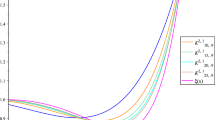Abstract
We consider eigenvaluesE λ of the HamiltonianH λ=−Δ+V+λW,W compactly supported, in the λ→∞ limit. ForW≧0 we find monotonic convergence ofE λ to the eigenvalues of a limiting operatorH ∞ (associated with an exterior Dirichlet problem), and we estimate the rate of convergence for 1-dimensional systems. In 1-dimensional systems withW≦0, or withW changing sign, we do not find convergence. Instead, we find a cascade phenomenon, in which, as λ→∞, each eigenvalueE λ stays near a Dirichlet eigenvalue for a long interval (of lengthO(\(\sqrt \lambda \))) of the scaling range, quickly drops to the next lower Dirichlet eigenvalue, stays there for a long interval, drops again, and so on. As a result, for most large values of λ the discrete spectrum ofH λ is close to that ofE ∞, but when λ reaches a transition region, the entire spectrum quickly shifts down by one. We also explore the behavior of several explicit models, as λ→∞.
Similar content being viewed by others
References
Abramowitz, M., Stegun, I. A.: Handbook of mathematical functions. New York: Dover 1972
Alama, S., Deift, P., Hempel, R.: Eigenvalue problems arising in the theory of the color of crystals (to appear)
Albeverio, S., Gesztesy, F., Høegh-Krohn, R., Holden, H.: Solvable models in quantum mechanics. Texts and Monographs in Physics. Berlin, Heidelberg, New York: Springer 1988
Ashbaugh, M. S., Harrell, E. M.: Perturbation theory for shape resonances and large barrier potentials. Commun. Math. Phys.83, 151–170 (1982)
Baumgärtel, H., Demuth, M.: Decoupling by a projection, Rep. Math. Phys.15, 173–186 (1979)
Bulla, W., Gesztesy, F.: Deficiency indices and singular boundary conditions in quantum mechanics. J. Math. Phys.26, 2520–2528 (1985)
Deift, P. A.: Applications of a communication formula, Duke Math. J.45, 267–310 (1978)
Deift, P. A., Hempel, R.: On the existence of eigenvalues of the Schrödinger operatorH—λW in a gap ofσ(H). Commun. Math. Phys.103, 461–490 (1986)
Dunford, N., Schwartz, J. T.: Linear Operators II. New York: Interscience 1963
Gesztesy, F., Simon, B.: On a theorem of Deift and Hempel. Commun. Math. Phys.116, 503–505 (1988)
Grinberg, A. A.: Energy spectrum of an electron placed in the fields of a small-radius potential well and an attractive coulomb potential. Sov. Phys. Semicond.11, 1118–1120 (1977)
Harrell, E. M.: The band structure of a one-dimensional periodic system in a scaling limit. Ann. Phys.119, 351–369 (1979)
Hempel, R.: A left-indefinite generalized eigenvalue problem for Schrödinger operators. Habilitationsschrift, University of Munich, FRG, 1987
Hempel, R., Hinz, A. M., Kalf, H.: On the essential spectrum of Schrödinger operators with spherically symmetric potentials. Math. Ann.277, 197–208 (1987)
Hille, E., Phillips, R. S.: Functional analysis and semigroups. Rev. ed., Providence, RI: Am. Math. Soc. Colloq. Publ.31, (1957)
Kato, T.: On the Trotter-Lie product formula. Proc. Jpn. Acad.50, 694–698 (1974)
Kato, T.: Trotter's product formula for an arbitrary pair of self-adjoint contraction semi-groups. In: Topics in functional analysis. Adv. Math. Suppl. Stud.3, 185–195 (1978)
Kato, T.: Monotonicity theorems in scattering theory. Hadronic J.1, 134–154 (1978)
Kato, T.: Perturbation theory for linear operators. 2nd corr. (ed.), Berlin, Heidelberg, New York: Springer 1980
Klaus, M.: Some applications of the Birman-Schwinger principle. Helv. Phys. Acta55, 49–68 (1982)
Kudryavtsev, A. E., Markushin, V. E., Shapiro, I. S.: Nuclear level shift in the (p21-1) Atom. Sov. Phys. JETP47, 225–232 (1978)
Olver, F. W. J.: Asymptotics and special functions. New York: Academic Press 1974
Pötz, W., Vogl, P.: High magnetic field effects on shallow and deep impurities in semiconductors. Solid State Comm.48, 249–252 (1983)
Popov, V. S.: On the properties of the discrete spectrum for Z close to 137. Sov. Phys. JETP33, 665–673 (1971)
Reed, M., Simon, B.: Methods of modern mathematical physics I: Functional analysis, rev. and enlarged ed., New York: Academic Press 1980
Reed, M., Simon, B.: Methods of modern mathematical physics IV: Analysis of operators. New York: Academic Press 1978
Saxon, D. S., Hutner, R. A.: Some electronic properties of a one-dimensional crystal model. Phillips Res. Rep.4, 81–122 (1949)
Simon, B.: Coupling constant analyticity for the anharmonic oscillator. Ann. Phys.58, 76–136 (1970)
Simon, B.: Lower semicontinuity of positive quadratic forms. Proc. Roy. Soc. Edinburgh79, 267–273 (1977)
Simon, B.: A canonical decomposition for quadratic forms with applications to monotone convergence theorems. J. Funct. Anal.28, 377–385 (1978)
Thirring, W.: A course in mathematical physics Vol. 3: Quantum mechanics of atoms and molecules. Berlin, Heidelberg, New York: Springer 1981
Veselić, K.: Perturbation of pseudoresolvents and analyticity in 1/c in relativistic quantum mechanics. Commun. Math. Phys.22, 27–43 (1971)
Vogl, P.: Chemical trends of deep impurity levels in covalent semiconductors. In: Festkörperprobleme XXI (1981), pp. 191–219. Wiesbaden, Vieweg
Weidmann, J.: Oszillationsmethoden für systeme Gewöhnlicher Differentialgleichungen. Math. Z.119, 349–373 (1971)
Weidmann, J.: Linear operators in Hilbert spaces. Graduate texts in mathematics Vol.68, Berlin, Heidelberg, New York: Springer 1980
Zel'dovich, Ya.B.: Energy levels in a distorted Coulomb field. Sov. Phys. Solid State1, 1497–1501 (1960)
Author information
Authors and Affiliations
Additional information
Communicated by A. Jaffe
Max Kade Foundation Fellow
Partially supported by USNSF under Grant DMS-8416049
On leave of absence from Department of Mathematics and Statistics, Case Western Reserve University, Cleveland, OH 44106, USA. Partially supported by USNSF under Grant DMS-8620231 and the Case Institute of Technology, RIG
Rights and permissions
About this article
Cite this article
Gesztesy, F., Gurarie, D., Holden, H. et al. Trapping and cascading of eigenvalues in the large coupling limit. Commun.Math. Phys. 118, 597–634 (1988). https://doi.org/10.1007/BF01221111
Received:
Issue Date:
DOI: https://doi.org/10.1007/BF01221111



